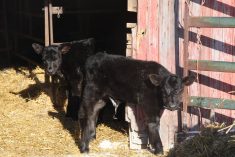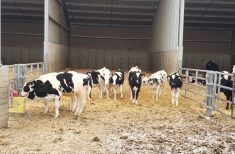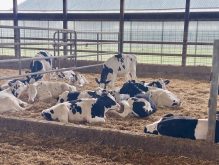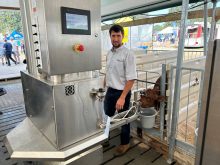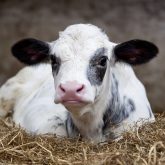We have known that colostrum is important to calf health for a long time. Calves are born with an immature immune system and they depend on the intake of antibodies in colostrum called immunoglobulin G, or IgG, to protect them during early life.
This process is called the transfer of passive immunity. However, our understanding of the who, when, what, and how of colostrum management for beef calves continues to evolve.
Obviously, the ideal situation is that calves are born without any help, get up quickly and nurse lots of good quality colostrum from their dam shortly after birth. The questions arise when this doesn’t happen.
Read Also

Dissolving eartags could make pig traceability easier
A dissolving eartag for market hogs, called Clean Trace could reduce processing challenges and enable more individual management of pigs.
Why it matters: Ensuring calves get enough colostrum in the first hours is critical for their survival and long-term health.
In recent research conducted at the University of Calgary’s Faculty of Veterinary Medicine, we tackled the questions of what colostrum is best for beef calves and how it should be delivered?
Here’s what we found:
What is the best colostrum for beef calves?
We conducted a study to help answer this question, and it is publicly available. In it, we compared three colostrum feeding strategies: a small volume of high IgG concentration colostrum product (one litre with 100 grams per litre of IgG), a moderate volume of moderate IgG product (1.4 litres with 70 grams per litre of IgG), and a high volume of high IgG product (two litres with 100 grams per litre of IgG). All calves were fed within one hour of birth using a tube feeder.
Calves in the moderate group nursed sooner than calves in the other two groups but all the calves in this study absorbed enough IgG, regardless of the colostrum feeding strategy.
Most calves nursed at least one additional colostrum feeding from their dam and those that did not were hand-fed colostrum product again at eight hours (one calf) and at 20 to 24 hours (three calves).
In practical terms, this study suggests that getting at least 100 grams of IgG into calves within an hour of birth resulted in successful transfer of passive immunity and generally did not interfere with calves subsequently suckling their dam.
In another study, we collected colostrum samples from more than 400 beef cows and heifers from 11 cow-calf operations. On average, that colostrum contained 150 grams per litre of IgG. This means that maternal colostrum will often have much higher concentrations of IgG than packaged products.
This is also more than double the 64 grams per litre of IgG that we found was the average IgG concentration for dairy cows in Alberta. As such, I would recommend using your own cows’ colostrum when possible but still have a good quality colostrum product (one that contains at least 100 grams of IgG per package) on hand for when maternal colostrum is not an option.
I would strongly discourage using dairy cow colostrum.
What about calves that won’t nurse?
The question of how best to feed colostrum to calves that do not nurse from their dam is another frequent issue.
We aimed to answer this question in a study where we fed calves one litre of colostrum product with 100 grams per litre of IgG, either by bottle or tube feeder within one hour of birth. Some calves refused the bottle so were tube-fed the remainder of their colostrum.
We found that calves that drank all their colostrum from a bottle nursed from their dams sooner and had a lower risk of inadequate transfer of passive immunity than the other calves.
There was no difference between calves that received all or part of their colostrum by tube.
We did not see any evidence of nipple confusion in this study and based on these results, I would suggest bottle feeding calves when possible. Calves that do not finish their bottle should be tube-fed the rest, but we should keep a close eye on those calves to make sure they get up and nurse from their dam again soon.
There is no one-size-fits-all strategy that works for all herds in terms of colostrum management. However, understanding some fundamentals about what we should be feeding and how we can assist calves with colostrum consumption allows us to ensure each calf can get the protection it needs to stay healthy early in life.
Starting a calf off right can make a world of difference to getting them through to weaning alive and well.



